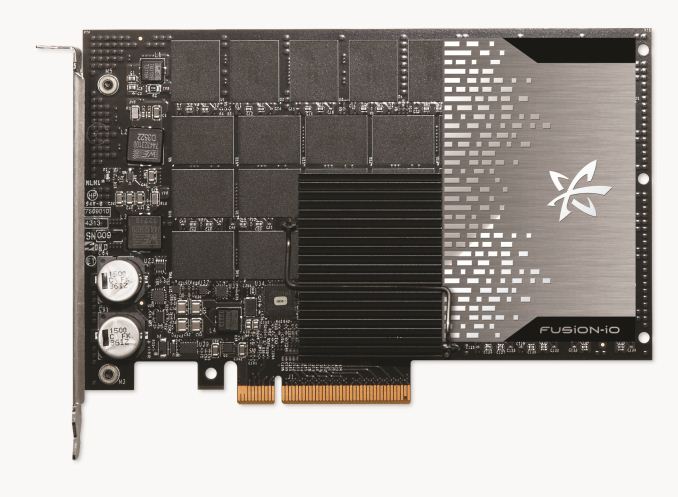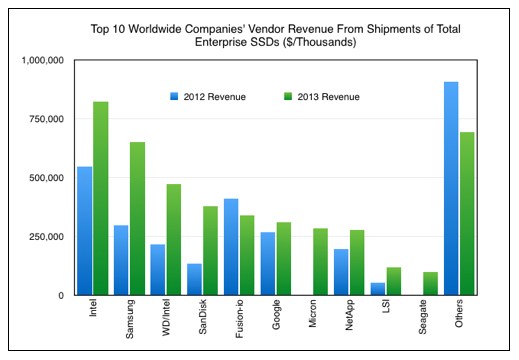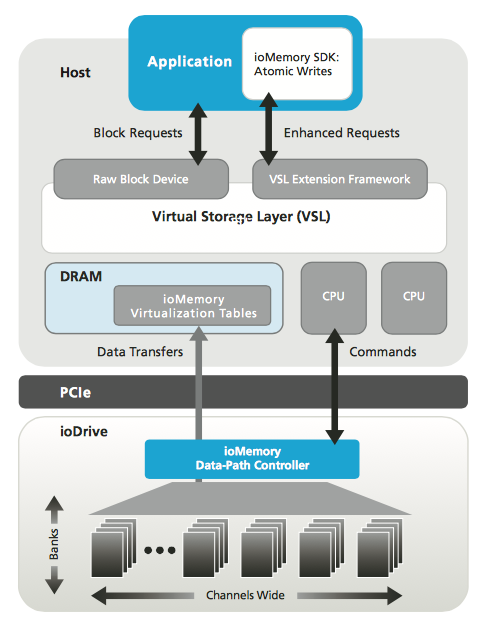The State of SanDisk
by Kristian Vättö on December 5, 2014 8:00 AM ESTThe Enterprise
In mid-July SanDisk announced their acquisition of Fusion-io and the acquisition was completed a couple of week prior to Flash Memory Summit. I posted my initial thoughts when the news hit the public, but I feel that it's worth doing a bit deeper analysis now that I have given it some more thought and discussed it with John Scaramuzzo, senior vice president and general manager of SanDisk's enterprise business.
SanDisk has managed to establish itself as one of the key players in the enterprise SSD space over the past few years. The acquisitions of Pliant in 2011 and SMART Storage Systems in 2013 provided SanDisk with strong expertise and product lineups for SATA and SAS SSDs but left the company without a solid long-term plan for PCIe. I heard Pliant's initial roadmap included plans for PCIe-based solutions as well, but it looks like those plans never materialized.
Up until the Fusion-io acquisition, the Lightning PCIe SSA was the only PCIe solution in SanDisk's enterprise product portfolio, and as a matter of fact that drive is internally a SAS-based design with a PCIe to SAS bridge onboard. In other words, SanDisk had practically zero real PCIe solutions for the enterprise, while at the same time SanDisk's biggest competitors, such as Intel and Samsung, have had PCIe drives for a long while already.
Fusion-io's 3.2TB Atomic Series SSD
Fusion-io's strategy and product portfolio, on the other hand, was a complete opposite. From the beginning Fusion-io has focused on PCIe storage, which dates all the way back to 2007 when the company released its first ioDrive that utilized a PCIe x4 interface and was capable of speeds up to 800MB/s. Not only was Fusion-io early in the market, but the company was also able to garner a few massive and very important clients – the most notable being Facebook and Apple. I don't think it's an overstatement to say that Fusion-io can be considered as the pioneer of PCIe storage because it was the first company to turn PCIe SSDs and storage in general into a large, successful business.
But stories eventually come to an end. The competitive advantages Fusion-io had were its PCIe technology and several high-level customers, but the advantages were lost when the NAND manufacturers stepped into the PCIe territory. It's nearly impossible for a company that has to source its NAND from a third party to compete against another company that manufactures NAND in-house since the latter will always have advantages in cost. While Fusion-io didn't lose its customers to competitors overnight, it's clear that especially Intel and Samsung snagged a share of Fusion-io's business in the past couple of years.
In a nutshell, the acquisition brings SanDisk the long-needed expertise in PCIe storage along with Fusion-io's broad PCIe product portfolio. The acquisition is now a bit over 100 days in and the Fusion-io employees have been integrated into SanDisk's existing teams. Initially Fusion-io's engineering team was separate and worked under Lance Smith, the former President and COO of Fusion-io, but Mr. Smith decided to leave SanDisk and pursue other options. Last week a data virtualization startup Primary Data announced that Mr. Smith has joined the company as the new CEO, which explains his quick departure from SanDisk.
All the engineering talent has now been unified and the team is lead by Mr. Scaramuzzo. With everyone under the same roof, the roadmaps are now in the process of being integrated to bring the expertise together. It will be a while before we see the fruits of the acquisition, but in the meantime the latest Fusion-io products will transition to SanDisk NAND for increased cost efficiency.
But what about NVMe? That has been the hot topic in the industry this year and I bet many of you are wondering what is SanDisk's and Fusion-io's play in that field. The short version of their strategy is that Fusion-io already has a technology called Virtual Storage Layers (VSL), which is essentially a driver/software stack similar to NVMe. The truth is that NVMe isn't really anything new from a technology perspective, but what makes it alluring for many manufacturers is the fact that the NVMe drivers are universal and already supported by the latest operating systems. Technologies like VSL are rather expensive to develop and require expertise because there is no framework available (i.e. everything has to be developed from scratch), but on the other hand an in-house driver like VSL allows for more customization and optimization.
However, that doesn't mean that SanDisk has no interest on NVMe whatsoever. The company sees that as the entry and mid-level enterprise SSDs move from SATA and SAS to PCIe, NVMe will be one of the key factors because of easy and quick deployment. For that market segment the NVMe spec and its limitations are fine – it's only the high-end segment where the benefits of VSL are more prominent. It's actually likely that many manufacturers will turn to custom NVMe drivers anyway for higher and more optimized performance, and in fact that is already happening with Intel providing its own NVMe driver for the P3600/P3700.
Lastly, let's quickly discuss the ULLtraDIMM. I wrote a quick piece on ULLtraDIMM right after Flash Memory Summit, but SanDisk has already scored Huawei as the third ULLtraDIMM partner (in addition to IBM and Supermicro). The first generation product that is currently available is internally based on a pair of SATA 6Gbps controllers, but SanDisk said that a native DDR to NAND controller is possible in the future if the market adopts the new form factor well. As usual, the industry is fairly slow in adopting new form factors, so it's hard to say whether NAND DIMMs will really take off, but it's a very interesting and potentially useful technology.
Final Words
All in all, SanDisk is definitely one of the most interesting NAND companies going forward. USB drives, eMMC solutions, SSDs and even the storage arrays from the Fusion-io acquisition are all built on NAND, which puts SanDisk in a unique position as it's the only NAND manufacturer that focuses solely on NAND products. The company can't turn to alternative revenue sources like e.g. Intel and Samsung can, but on the other hand that's also SanDisk's strength as all the know-how and experience in the company is related to NAND in one way or the other.
Ultimately next year will be crucial for SanDisk because it determines whether the company can materialize all the underlying potential from the Fusion-io acquisition and become a serious competitor to Intel and Samsung in the enterprise space. The pieces are definitely there, so it's just a matter of execution now.














132 Comments
View All Comments
cjs150 - Friday, December 5, 2014 - link
Complete agree. My 6TB NAS is starting to feel a bit small.As for cloud and streaming, this is what the industry wants not necessarily what consumers want. There are many places where there is no or limited access to the cloud and mobile networks are not going to reduce data transmission costs sufficiently anytime soon
hojnikb - Friday, December 5, 2014 - link
Nothing is forcing you not to buy extra storage. But for lots of people 128GB/256GB is more than plenty.Spawne32 - Friday, December 5, 2014 - link
If you don't want to listen to what people are telling you is the problem, I don't know what to tell you. Cloud storage is not "mainstream" by any sense of the word. It is something that the younger generation of users are just starting to embrace, but for the vast majority of us, we would rather keep our information stored locally then over a network for security reasons alone, not to mention the fact that cloud storage can be costly. The average user has roughly 500gb of information stored on their computer between games, photos and music, that would not be traded off for cloud storage. Yet the price of a 500gb SSD is still between 175 to 200 dollars.piiman - Saturday, December 6, 2014 - link
"cloud storage can be costly."And it's SLOOOOOWWWW why even compare the two.
One is a drive for active files and games one is for inactive and seldom accessed files.
You want to make SSD's more popular? Get the price and size to match HDD's and you're golden.
Shadow Cat - Wednesday, January 7, 2015 - link
I agree with piiman, commercial cloud storage is not a sensible option.As long as SSDs stay at the back end of storage capacity race, they will stay at the bottom of the consumer adoption rate.
amddude10 - Sunday, December 7, 2014 - link
True, although it's nice to have at least two drives, so that you can backup important things much more quickly and conveniently than using cloud services.amddude10 - Sunday, December 7, 2014 - link
Yep, I've got a 2TB and a 1TB drive plus a 256GB SSD, and I find that I keep needing to go through my files and deleting them to make space every couple of months now. I could definitely use another drive.groundhogdaze - Friday, December 5, 2014 - link
Games are taking a lot more space nowadays. Recent games can take 30-50GB each. My STEAM library alone is already 1.5TB and I haven't even installed all the games I've owned yet which probably bring it closer to 3TB of games.Sabresiberian - Saturday, December 6, 2014 - link
It's an easy thing for those of us that have reliable and fast internet service to say, but the fact is a large portion of the population has neither. I think we are still a decade or two away from that being a reality.Wwhat - Sunday, December 7, 2014 - link
I know of a few adult non-IT women who do use plenty of storage. And they normally don't like the cloud at all and have internetspeeds that really make the cloud a silly proposition. For clouds to even start replacing drives you'd need people to be a) really out of the loop and stupid regarding privacy issues b) people must have at least fiber and with equal up and download speeds.The cloud at this moment is a dumb illusion some poorly managed companies try to bet on.